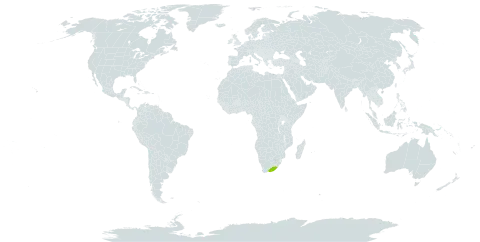A slender glabrous shrublet, erect or ascending, up to 5 dm high, sympodially branching with 2-several branches in each ramification. (Branching sometimes almost monopodial through the ± complete suppression of all but one branch.) Stems and branches closely leafy, towards the base clothed with withered leaf remains, at length denuded basally. Leaves very closely set, spreading, entire, subulate-filiform, 7-13 mm long, at the base c. 0.5 mm wide and ± semiterete, tapering to very fine and narrow, setiform points. Peduncles terminal at the ramifications (sometimes through unequal dichotomy or complete suppression of lateral branches appearing in a lateral position), solitary, erect-ascending, often somewhat flexuous, filiform and slender, 3-9 cm long, 0.2-0.3 mm thick, slightly thickened at the involucre-base, terete. Involucre campanulate, 5-7 mm in diam. Involucral bracts uni-seriate, 8, ovate-lanceolate, 3-4 mm long, basally connate to c. 1/4-1/3, 3-lined, subacute and puberulous-tipped. Receptacle convex-conical, shallowly alveolate. Ray-florets 8, yellow. Tube cylindrical, 0.6-1 mm long. Lamina elliptic-oblong, 5-7 mm long, 1-2 mm wide, 4(-6)-veined. Style terete; style branches c. 0.4 mm long, truncate or emarginate. Disc-florets c. 15-30. Corolla 2-2.5 mm long. Tube cylindrical, c. 0.5 mm long. Limb campanulate, 1.5-2 mm long; lobes deltoid-ovate, 10.5-0.7 mm long. Anthers c. 1 mm long incl. the ovate obtuse appendage. Style terete with swollen base; style branches c. 0.2 mm long, with; truncate or slightly convex tips. Pappus 0. Achenes (immature) oblong-obovate, glabrous.
More
Slender, glabrous shrublet, erect or ascending, up to 500 mm high, always branching into 1-several stems, stems closely leafy above, with old leaf remains below, denuded basally. Leaves very closely set, entire, subulate-filiform. Peduncle terminal, solitary, erect to ascending, 30-90 mm long. Capitula 10-15 mm in diam.; involucre campanulate, 3-7 mm in diam., uniseriate, ovate to lanceolate, 3-4 mm long, connate to 1/4-1/3, 3-lined. Receptacle convex to conical, ± alveolate. Ray florets yellow. Disc florets 15-30. Flowering time Feb.-June. Cypselae oblong-obovate, glabrous.
